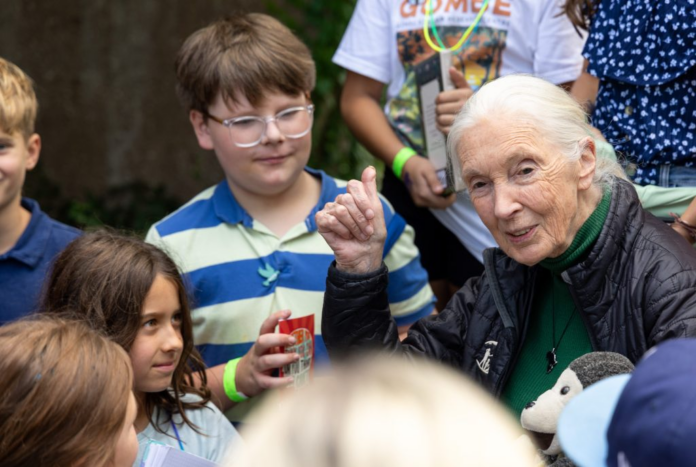Jane Goodall’s lifelong studies into chimpanzees began six decades ago, when as a 26-year-old she set foot on the shores of Gombe Stream National Park along Lake Tanganyika in Tanzania, equipped with nothing but a notebook, a pencil and a pair of secondhand binoculars.
But it was later, at a 1986 conference on chimpanzees in Chicago, that she would experience a pivotal moment in her work. Learning about threats to chimpanzees, including the meat trade and their unethical treatment in some laboratories, shifted her focus toward a big-picture, holistic approach to the conservation of the species she had come to know so intimately.
“I just knew I had to try to do something,” she recalled at a luncheon Thursday, during a three-day return visit to Chicago. “That conference changed my whole life.”
Her commitment remains as strong as ever. At 91, the conservationist travels some 300 days every year, her team says, seeking to inspire thousands of people through lectures, speaking tours and media appearances. Beginning Thursday, the Lincoln Park Zoo brought Chicagoans into close contact with Goodall at different events, including the luncheon that was organized by the zoo’s women’s board to celebrate the work of women in wildlife conservation.
On Saturday, families gathered inside the Kovler Lion House to hear the world-renowned scientist talk about Roots and Shoots, a community-led conservation program from the Jane Goodall Institute to empower youth with resources for practical solutions to environmental and conservation challenges.
Sitting at a table next to her podium in the lion house, Mr. H — a primate plushie and birthday gift from a friend in 1996 — has visited 64 countries with Goodall and has been petted by some 5,000 people, according to her estimates. When she holds it, she caresses it gently. Her hands travel down the plushie’s spine, and her fingers pinch its tail.
She recalls coyly telling her friend: “Gary, chimps don’t have tails.”
When she left Tanzania in the 1960s to earn her doctorate in ethology, the study of animal behavior, at Cambridge University, she was advised against talking about chimpanzees’ personalities, emotions or problem-solving capabilities.
“Because scientists must be objective,” she was told. “They have to be cool and scientific and objective.”
But she was fortunate to have a teacher, as a child, who had taught her that “they were talking absolute rubbish,” she said, that humans were not the only creatures with personality.
That teacher? Her family’s dog.
“We’ve come a long way in our attitude towards other-than-human animals, and we’re treating (them) with full respect, understanding that they are individual beings with their own personalities,” she said.
Chimpanzees are the closest animal relatives to humans, sharing 98.8% of genetic material. They also display similar behaviors, such as kissing, embracing and holding hands. Young ones learn from their parents. They have a loving, compassionate, altruistic side. But they are also brutally territorial and can kill members of neighboring communities or social groups.
“I always think of two male chimpanzees competing for dominance, standing upright, swaggering about, shaking a fist,” Goodall said. Then, she quipped: “Maybe it reminds you of some human male politicians.”
Despite her research disproving many long-held scientific beliefs that humans were the only creatures who used tools or had emotions and personalities, it did reinforce one distinguishing feature that set people apart.
“The biggest difference is this brain up here,” she tapped her head.
Animals cannot design rockets to send to Mars or the internet, Goodall said: Only human intellect allows for that.
“And, sadly, we have not used it wisely,” she said. “I say we’re the most intellectual creature. But we’re certainly not the wisest, because a wise creature doesn’t destroy itself, and we’re destroying planet Earth as we speak.”
She remembers becoming depressed in the 1980s about the state of the world, meeting young people, high schoolers and university students across many countries who felt similarly. Others were angry or just apathetic. Most of them said the same thing: “You’re harming our future, and there’s nothing we can do about it.”
Despite the historical misuse of human intellect — with humanity leading increasingly materialistic lifestyles and prioritizing short-term profit at the expense of future generations, in her own words — it’s also a characteristic that gives her hope. That, and the resilience of nature, the power of young people and the indomitable human spirit.
“Hope isn’t just wishful thinking. Not at all,” she said. “For me, hope comes with taking action, seeing that you can make a difference.”
And that change doesn’t need to happen in a faraway land.
“Nature is everywhere. I could tell you,” she said, “about me being in the middle of a city, in the middle of an airport, and seeing an amazing story about nature.”
At the Thursday luncheon, Goodall concluded her talk in the same way that she has ended many lectures over the years, with help from the audience.
“Are you ready? One, two, three,” she counted down.
Attendees intoned alongside her: “Together we can, together we will, together we must —”
“— change the world,” Goodall finished in a quiet, firm voice.



